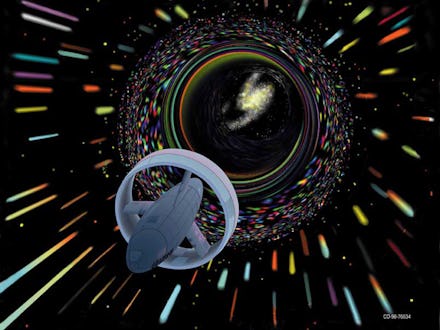Wormholes could finally unite two of history's biggest physics theories

New research may have found a solution to one of the biggest problems in physics.
Scientists have been trying for decades to reconcile Einstein's theory of general relativity (the physics that govern large objects) and quantum mechanics (the physics that govern very small objects). Even though both theories are great at describing things in their own realm, the math doesn't work out when you try to combine them.
Now scientists think that wormholes might be the solution, and they even have an equation to combine the two theories: ER = EPR.
Wormholes are theoretical tunnels through the fabric of space-time. They show up in science fiction like the movie Interstellar and the TV show Doctor Who. Wormholes might be a perfect bridge between the two theories because Einstein's theory predicts their existence, and they might be related to a concept in quantum mechanics called entanglement.
Forget R+L=J. It's all about ER = EPR.
The left side of the equation, "ER," stands for Einstein and Nathan Rosen, who together wrote a paper describing wormholes. Wormholes are also referred to as Einstein-Rosen bridges. The right side of the equation, "EPR," stands for Einstein, Rosen and Boris Podolsky, who were the three authors on another paper that described quantum entanglement.
Now, physicist Leonard Susskind recently published a paper outlining how those two Einstein papers are related.
The theory: Wormholes and quantum entanglement might almost be the same thing.
"ER = EPR tells us that the immensely complicated network of entangled subsystems that comprises the universe is also an immensely complicated (and technically complex) network of Einstein-Rosen bridges," Susskind wrote. "To me it seems obvious that if ER = EPR is true it is a very big deal, and it must affect the foundations and interpretation of quantum mechanics."
Quantum entanglement is usually explained as two particles linked in a way that as soon as one thing happens to one particle, the same thing instantly happens to the other particle no matter how far apart they are. But Susskind argues that other things, like black holes for example, can also be entangled. Two entangled black holes on opposite sides of the universe could be linked by a wormhole.
The implications: This could be huge. We'd finally have a connection between general relativity and quantum mechanics, and we'd be another step closer to a grand "theory of everything." We'll need a lot more research to confirm the idea though.
"What all of this suggests to me, and what I want to suggest to you, is that quantum mechanics and gravity are far more tightly related than we (or at least I) had ever imagined," Susskind concludes in his paper.